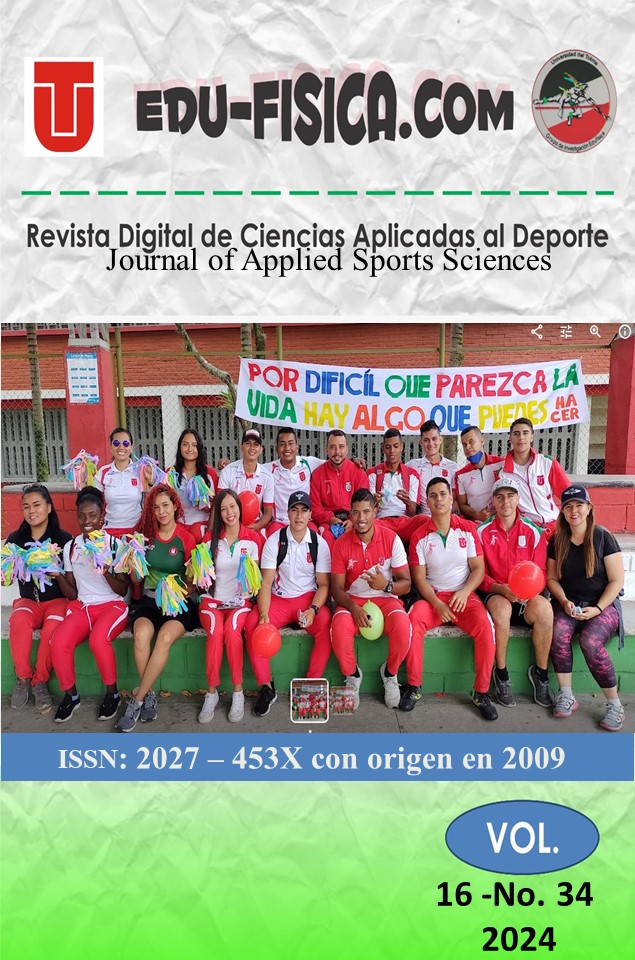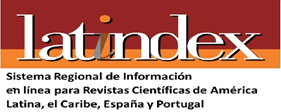CARGA DE ENTRENAMIENTO DEL DEPORTE
DOI:
https://doi.org/10.59514/2027-453X.3117Palabras clave:
Carga de entrenamiento, Deporte, Entrenamiento,, PeriodizaciónResumen
El objetivo de la revisión fue explicar los temas de carga de entrenamiento y sobre la teoría que sustenta científicamente la carga de entrenamiento. Hay siete temas que ayudan a estructurar la carga de entrenamiento. Los contenidos teóricos que sustentan científicamente la carga de entrenamiento son el síndrome de adaptación general, la supercompensación y la teoría de los dos factores, también conocida como teoría de la fatiga y el acondicionamiento físico. En conclusión, la carga de entrenamiento es un contenido muy importante para mejorar el rendimiento.
Descargas
Citas
Barbanti, V. (2001). Treinamento físico: bases científicas. 3ª ed. São Paulo: CLR Balieiro.
Bértola, D. (2010). Hans Selye y sus ratas estresadas. Medicina Universitaria, 12(47), 142-143.
Bokan, B. (2010). L. P. Matveyev: theory and methodology of physical culture. Physical Culture, 64(1), 79-90.
Bompa, T. (2004). Treinamento de potência para o esporte. São Paulo: Phorte.
Buckner, S., Jessee, M., Mouser, J., Dankel, S., Mattocks, K., Bell, Z., Abe, T., e Loenneke, J. (2020). The basics of training for muscle size and strength: a brief review on the theory. Medicine and Science in Sports and Exercise, 52(3), 645-653.
Carvalho, N., e Machado, A. (2022). Comportamento da frequência cardíaca, pressão arterial e duplo produto em atletas de judô. Revista Brasileira de Educação Física e Esporte, 36(-), 1-9.
Costa, I. (2022). Preparación física para el fitness y el deporte de rendimiento: una mirada revisionista. Mar del Plata: Universidad FASTA.
Collazo Macías, A. (2020, 4 julio). Sistema de entrenamiento multifásico: una propuesta teórica metodológica para la planficación del entrenamiento. 1ra Conferencia Online de Ciencias aplicadas al Deporte de Alto Rendimiento - COCAR. [Curso online]. Organização: INDER.http://www.inder.gob.cu/eventos/cocar2020/documentos/Dr._C._Adalberto_Collazo_Mac%C3%ADas_(Planificaci%C3%B3n).pdf
Cunanan, A., DeWeese, B., Wagle, J., Carroll, K., Sausaman, R., Hornsby, W., Haff, G., Triplett, N., Pierce, K., e Stone, M. (2018). The general adaptation syndrome: a foundation for the concept of periodization. Sports Medicine, 48(787), 1-12.
Dantas, E. (1995). A prática da preparação física. 3ª ed. Rio de Janeiro: Shape.
Dantas, E., Luján, J., Bispo, M., Godoy, E., Santos, C., Bello, M., e Cuadras, G. (2022). Criteria for identifying and assessing sports training periodization models. Retos, -(45), 174-183.
Forteza, A. (2001). Treinamento desportivo: carga, estrutura e planejamento. São Paulo: Phorte.
Forteza, A. (2004). Treinar para ganhar: a versão cubana do treinamento desportivo. São Paulo: Phorte.
Forteza, A., e Farto, E. (2007). Teoría, metodologia y planificación del entrenamiento: de lo ortodoxo a lo contemporáneo. Sevilla: Wanceulen.
Jackson, M. (2012). The pursuit of happiness: the social and scientific origins of Hans Selye´s natural philosophy of life. History of the Human Sciences, 25(5), 13-29.
Leshem, Y., e Kuiper, P. (1996). Is there a GAS (general adaptation syndrome) response to various types of environmental stress? Biologia Platarum, 38(1), 1-18.
Marques Junior, N. (2017). Carga de treino do esporte de alto rendimento: revisitando o conteúdo. Revista Europa del Este Unida, -(3), 42-74.
Marques Junior, N. (2020a). Periodization models used in the current sport. MOJ Sports Medicine, 4(1), 27-34.
Marques Junior, N. (2020b). Specific periodization for the volleyball: the importance of the residual training effects. MOJ Sports Medicine, 4(1), 4-11.
Marques Junior, N. (2022). Periodização para o esporte contemporâneo. Revista de Investigación Cuerpo, Cultura y Movimiento, 12(2), 1-22.
Marques Junior, N., e Pereira, T. (2013). Ajuste de curva monoexponencial da cinética do VO2: um estudo com Excel®. Lecturas: Educación Física y Deportes, 18(180), 1-21.
Marques Junior, N., Arruda, D., e Api, G. (2019). Periodização tradicional no voleibol (parte 1). Revista Con-Ciencias del Deporte, 1(2), 31-55.
Martins, F. (2003). A periodização tática segundo Vítor Frade. (Monografia). Porto, Universidade do Porto, Portugal.
Masson, G., e Selye, H. (1938). Réaction générale d`adaptation. Ses indications pratiques. Canadian Journal of
Comparative Medicine, 11(11), 282-285.
Matveev, L. (1977). Periodización del entrenamiento deportivo. Madrid: INEF.
Matveev, L. (1991). Fundamentos do treino desportivo. 2ª ed. Lisboa: Horizonte.
Matveev, L. (1995). Preparação desportiva. São Paulo: FMU.
Matveev, L. (1997). Treino desportivo: metodologia e planejamento. Guarulhos: Phorte.
Mitsumume, T., e Kayashima, E. (2013). Possibility of delay in the super-compensation phase due to aging in jump practice. Asian Journal of Sports Medicine, 4(4), 295-300.
Monteiro, A. (2002). Treinamento personalizado: uma abordagem didática-metodológica. 2ª ed. São Paulo: Phorte.
Monteiro, A., e Lopes, C. (2015). Periodização esportiva – estruturação do treinamento. 2ª ed. São Paulo: AG Editora.
Mukhopadhyay, K. (2021). Physiological basis of adaptation through super-compensation for better sporting result. Advances in Health and Exercise, 1(2), 30-42.
Mukhopadhyay, K. (2022). Concept of sports training periodization for better performance: a critical discussion. Turkish Journal of Kinesiology, 8(3), 83-96.
Navarro, F. (1998). La resistencia. Madrid: Gymnos.
Robert, A. (1985). My years with Selye. In. Half a century of stress research: a tribute to Hans Selye by his student and associates. Experientia, 41(5), 559-700.
Rondon, M., Santos, A., Martinez, D., Alonso, D., Rondon, E., e Zamo-Roth, F. (2010). Fisiologia integrativa no exercício físico. Em. C. Negrão, e A. Barretto (Eds.). Cardiologia do exercício: do atleta ao cardiopata (p. 38-72). 3ª ed. Barueri: Manole.
Selye, H. (1936). A syndrome produced by diverse nocuous agents. Nature, 138(32), 4.
Selye, H. (1937). Experimental production and prevention of appendicitis with histamine. Canadian Medical Association Journal, 36(5), 462.
Selye, H. (1938a). Adaptation energy. Nature, 21(-), 926.
Selye, H. (1938b). Experimental evidence supporting the conception of “adaptation energy”. American Journal of Physiology Legacy Content, 123(3), 758-765.
Selye, H. (1956). The stress of life. New York: McGraw-Hill Book Company.
Stone, M., Horsnsby, W., Haff, G., Fry, A., Suarez, D., Liu, J., Ravé, J., e Pierce, K. (2021). Periodization and block periodization in sports: emphasis on strength-power training – a provocative and challenging narrative. Journal of Strength and Conditioning Research, 35(8), 2351-2371.
Szabo, S., Taché, Y., & Somogyi, A. (2012). The legacy of Hans Selye and the origins of stress research: a retrospective 75 years after his land mark brief “letter” to the editor of Nature. Stress, 15(5), 472-478.
Szabo, S., Yoshida, M., Filakovszky, J., e Juhasz, G. (2017). “Stress” is 80 years old: from Hans Selye original paper in 1936 to recent advances in GI ulceration. Current Pharmaceutical Design, 23(-), 4029-4041.
Taché, Y. (1985). A tribute to the pioneering contributions of Hans Selye: an appraisal through his books. In. Half a century of stress research: a tribute to Hans Selye by his student and associates. Experientia, 41(5), 559-700.
Verkhoshanski, Y. (1999). The skills of programming the training process. New Studies in Athletics, 14(4), 45-54.
Vasconcelos Raposo, A. (2000). Planificación y organización del entrenamiento deportivo. Barcelona: Paidotribo.
Verkhoshanski, Y., e Siff, M. (2004). Superentrenamiento. Barcelona: Paidotribo.
Villar, C. (1987). La preparación física del futbol basada en el atletismo. 3ª ed. Madrid: Gymnos.
Viru, A. (2002). Early contributions of Russian stress and exercise physiologists. Journal of Applied Physiology, 92(4), 1378-1382.
Viru, A., e Viru, M. (2000). Nature of training effects. Exercise and Sport Science, -(-), 67-95.
Viru, A., e Viru, M. (2003). Análisis y control del rendimiento deportivo. Barcelona: Paidotribo.
Yakovlev, N. (1975). The role of sympathetic nervous system in the adaptation of skeletal muscle to increased activity. In.
H. Howald, e J. Poortmans (Eds.). Metabolic adaptation to prolonged physical exercise (p. 293-294). Birkhäuser: Basel.
Zakharov, A. (1992). Ciência do treinamento desportivo. Rio de Janeiro: GPS.
Zatsiorsky, V. (1999). Ciência e prática do treinamento de força. São Paulo: Phorte.
Descargas
Publicado
Cómo citar
Número
Sección
Licencia
Si el manuscrito es aceptado para publicación los derechos de reproducción serán de la Facultad de Ciencias de la Educación, Universidad del Tolima. Ninguna publicación, nacional o extranjera, podrá reproducir ni traducir los artículos ni sus resúmenes con fines comerciales, sin previa autorización escrita del Comité Editorial de la revista Edu-Física.










